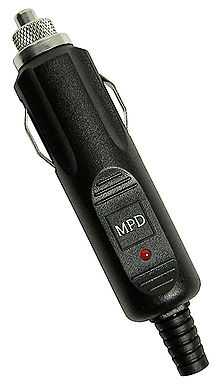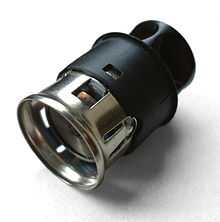Cigarette lighter receptacle


The cigarette lighter receptacle in an automobile, initially designed to power an electrically heated cigarette lighter, became a de facto standard DC connector to supply electrical power for portable accessories used in or near an automobile. While the cigarette lighter receptacle is a common feature of automobiles, as a DC power connector it has the disadvantage of relatively low current rating and poor contact stability.
Examples of devices that can be operated from a cigarette lighter receptacle include lights, fans, beverage heating devices, and small motorized tools such as gas compressors for inflating tires. Many portable electronic devices such as music players or mobile telephones use a cigarette lighter receptacle to recharge their internal batteries or to directly operate from the vehicle electrical system. Adapters for electronic devices may change voltage to be compatible with the supplied device. Devices that require alternating-current mains electricity can be operated with a plug-in inverter.
Currently, automobiles may provide several 12 V receptacles that are intended only to operate accessories and that are not to be used with a cigarette lighter. Car manufacturers may make a cigarette lighter an optional extra-cost accessory. Usually, only one 12 V receptacle near the driver will accommodate an actual cigarette lighter, with other receptacles designated as "12 V auxiliary power outlets" which are not physically able to power a car lighter.
History
The electrical cigar-lighter for gastronomic and home-use was invented and patented in the early 1880s by Friedrich Wilhelm Schindler (Germany). In the 1890s these tools were sold as electrical cigar-lighters (“Cigarrenanzuender”), and later as "Zigarrenanzuender" in the major German warehouse-catalogues. Probably in the 1920s they became cigarette-lighters, when cigarettes replaced cigars on the market widely.
In the United States cigar lighters started appearing as standard equipment in automobiles in 1925/26.[1] In 1928 the Connecticut Automotive Specialty Company in Bridgeport patented the first automotive cigar lighter with cord and reel. The modern "automatic" automotive V-Coil lighter was developed by Casco in 1956.[2]
In the reel-type lighters, the igniter unit was connected with a source of current by a cable which was wound on a spring drum so that the igniter unit and cable could be withdrawn from the socket and be used for lighting a cigar or cigarette. As the removable plug was returned to the socket, the wires were reeled back into it. The circuit was closed either by pressing a button or removing the igniter from its socket.[3]
In 1921, the Morris U.S. Patent 1,376,154 was issued for a so-called "wireless" or "cordless" lighter. This lighter eliminated the cables and the mechanism for winding and unwinding them. The igniter was heated in the socket then removed for use.[3]
Lighter use

The traditional lighter is a metal or plastic cylinder containing a thin coil of nichrome wire, through which high current (~10 amperes) passes when the device is activated, usually by pushing it into the socket as though it were a button. When pushed in, the lighter is held against the force of a spring by a hook attached to a bi-metallic strip.[4] The heating element becomes glowing orange hot in seconds, causing the bi-metallic strip to bend and unhook the mechanism, and the handle pops out. If the lighter is then promptly removed from its socket, it can light a cigarette, cigar or tinder.
Use as an electrical outlet
In newer cars, the socket often ships with a plastic dummy plug, without the lighter heating element due to declining popularity of smoking.[5] However, the socket continues to exist to power consumer electronics in cars as the primary purpose. Often, a vehicle may come with several outlets for convenience, some in the rear passenger area of the vehicle. Even the cargo area may be supplied with sockets for such purposes as powering portable GPS devices, recharging telephones, or powering a tire pump, a vacuum cleaner or a cooler. These usually have a plastic cap tethered to them, and are usually labeled as being only for DC power since they are not intended to withstand the heat produced by an electric cigarette lighter.
Twelve volt automobile plugs are standardized in the United States by UL Standard 2089 regarding vehicle battery adapters. This standard covers plugs and cord sets that insert into cigarette lighter receptacles. In Europe, 12 volt plugs and sockets are not specially regulated and do not require approvals for CE mark.
USB standard 5-volt outlets are offered in tandem with cigar lighter outlets in newer vehicles. The cigar lighter outlet has even enjoyed some popularity outside of automobiles, such as boats, and even non-vehicular applications on AC adapters that convert to 12 volt DC.
The male end is sometimes used to feed power into a vehicle to recharge a battery. For instance, portable solar battery maintainers generally connect to a vehicle's battery in this manner. Trickle chargers also sometimes connect in this way, eliminating the need to leave a vehicle's hood open as well as eliminating the possibility of reversed polarity.
Technical details
The sockets and mating plugs are defined in the ANSI/SAE J563 specification. For the 12 volt systems, the "contact point", which is the center part of the plug when viewed end-on, carries the positive voltage, whereas the "can" part, which is the outer part of the connector, carries the negative voltage (which is the "ground" connection for most automobiles, which have a negative ground electrical system).
12 volt auto connectors are made to comply with a standard by Underwriters Laboratories for safety. UL2089 was developed to cover the requirements for portable adapters rated 24 V DC or less that are intended to be supplied from the battery powered electrical system of a vehicle. Products covered by the standard include cord assemblies of a plug that mates with the standard cigarette receptacle found in automobiles.
- 6-volt cigar lighter receptacle and plug
- Receptacle inside diameter: 21.34 - 21.46 mm (median 21.4 mm)
- Plug body diameter: 21.08 - 21.23 mm (median 21.155 mm)
- 12-volt cigar lighter receptacle and plug, size A
- Receptacle inside diameter: 20.93 - 21.01 mm (median 20.97 mm)
- Plug body diameter: 20.73 - 20.88 mm (median 20.805 mm)
- Most often used in American automobiles.
- 12-volt cigar lighter receptacle and plug, size B
- Receptacle inside diameter: 21.41 - 21.51 mm (median 21.455 mm)
- Plug body diameter: 21.13 - 21.33 mm (median 21.18 mm)
- Most often used in European automobiles, and sometimes as a second socket in American automobiles expressly for DC power connections.
Plugs often include a pilot light to indicate a connection has been made.
Design considerations
Since the cigar lighter socket was designed to heat a cigar lighter, using these sockets as power connectors can lead to many problems. In addition to the issues with incompatible sizes, plugs can vibrate out of the socket under normal driving conditions, owing to poor retention. There have been reports of melted plug tips.[6] However, usage outside of vehicular applications can be especially beneficial in stationary settings since vibration is less of an issue when used as an alternative to 120 volt AC outlets.
A second problem is that nominally "Twelve-Volt" power in cars fluctuates widely. The actual voltage will be approximately 12.5 volts when dormant (less when cold), approximately 14.5 volts when the engine and the alternator/generator are operating (more when cold), and may briefly drop as low as 5-6 volts during engine start.[7] DC to DC converters will usually compensate for these small fluctuations.
Rarely, more extreme cases of voltage fluctuation can occur when the car battery is disconnected while the engine is running, or when the car receives a jump start. When the battery is disconnected, a load dump transient can produce very high voltages as the built in voltage regulator will try to charge a discharged/non present battery (disconnecting the battery while the engine is running may also ruin the diodes in the alternator). A car receiving a jump start from a truck will be subject to its 24 V electrical system.[8] A "double battery jump-start" is performed by some tow truck drivers in cold climates.[9]
Equipment intended to be powered by the receptacle needs to account for intermittent contact, and voltages outside the nominal 12 V DC like top voltage 9-16 V continuously, top voltage at 20 V during 1 hour, 24 V during 1 minute, 40 V during 400 ms.[10] Protection component tolerance example ratings are +50 to -60 V DC[11] Additionally, issues can occur with temperatures varying between -40 till +85 °C such as humidity and condensation.[10] Equipment connected this way must tolerate large variations in electrical- and climate environment.
See also
- Automobile accessory power
- Electric vehicle
- EmPower (aircraft power adapter)
- Inductive charging
- ISO 4165 connector
- Wiring harness
Notes
- ↑ Valdes-Dapena, Peter (2003-11-04). "Cigarette lighters: The new cupholders?". CNN.com. Retrieved 2007-06-05.
- ↑ "Casco Cigar lighter Facts & Figures". Casco. Retrieved 2007-06-05.
- ↑ 3.0 3.1 "Cuno Engineering v. Automatic Devices".
- ↑ U.S. Patent 5,932,126
- ↑ "Latest Gallup Update Shows Cigarette Smoking Near Historical Lows". Gallup.com. Retrieved 2009-04-08.
- ↑ "Testing power from car cigarette lighter socket ?". moneysavingexpert.com. Retrieved 2009-04-08.
- ↑ "Plugging the cigar lighter gap". Service Management 365. Retrieved 2007-05-30.
- ↑ Emadi, Ali (2005-05-25), Handbook of automotive power electronics and motor drives, CRC press, p. 119, ISBN 0-8247-2361-9,
The maximum operating voltage for 14 V systems is specified at 24 V, representing a double battery jump-start condition.
- ↑ "Double-Battery Jump Start", High-Frequency Automotive Power Supplies, Application note 3893 (Maxim Integrated Products), 2007-07-17,
Another steady-state OV condition is the double-battery jump start, which occurs when a tow truck or other service personnel use 24 V to jump-start a disabled vehicle or otherwise charge a dead battery. The typical OEM test requirement for this condition is about 24 V for two minutes. Some systems related to safety and engine management are required to operate under these conditions.
- ↑ 10.0 10.1 fordemc.com - EMC_CS_2009rev1.pdf
- ↑ national.com - LM2931
References
- Standards And Specs For In-Seat Power On Aircraft Still In The Clouds discusses mechanical and electrical deficiencies of using the cigar lighter socket for power.
- SAE J563 (Six- and Twelve Volt Cigar Lighter Receptacles)
- SAE/USCAR-4 (Standard for Cigar Lighters and Power Outlets) (USCAR=United States Council for Automotive Research)
- Automotive voltage transients